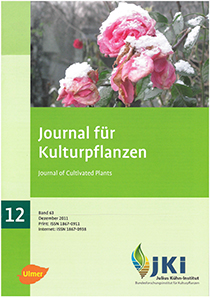Structure of arthropod communities in Bt maize and conventional maize – results of redundancy analyses of long-term field data from the Oderbruch region in Germany
Keywords:
Arthropods, spiders, carabids, community composition, Bt maize, biodiversity, redundancy analysisAbstract
The arthropod biodiversity was investigated in half-fields planted with Bt maize (BT) and non-insecticide treated conventional maize (CV) and in one-third fields planted with BT and CV plus either isogenic (IS) or insecticide-treated conventional maize (IN) in the Oderbruch region in the state of Brandenburg, Germany, an important outbreak area of the European corn borer, Ostrinia nubilalis (Hübner), from 2000 to 2008. Three different arthropod communities – plant dwelling arthropods (PDA), epigeic spiders (ES) and ground-dwelling carabids (GDC) – were enumerated by counting arthropods on maize plants during flowering (PDA, 2000 to 2007) or by pitfall trapping four weeks after the beginning of flowering (ES and GDC, 2000 to 2008). The counted arthropods (PDA) were determined to different taxonomic levels, and the spiders and carabids captured in pitfall traps were identified to species level. The data were systematized and verified for choice of appropriate statistical method. Redundancy analysis (RDA) proved to be a suitable method. The results showed that 83.2% of species variation in PDA was explained by year-site-date combinations and maize variant. Bt maize contributed only 1.2% to species composition, but this low rate was significant. Regarding the spiders and carabids communities, 66.3% and 82.7% of species variation was caused by year-site combinations and maize variant, respectively. The contribution of Bt maize was low but significant in both communities (1.5% and 1.2%, respectively). The results correspond with those of other studies. They show the enormous dynamics of arthropod communities on maize plants and on the ground and the relatively low effect of maize variant.
DOI: 10.5073/JfK.2011.12.01, https://doi.org/10.5073/JfK.2011.12.01








